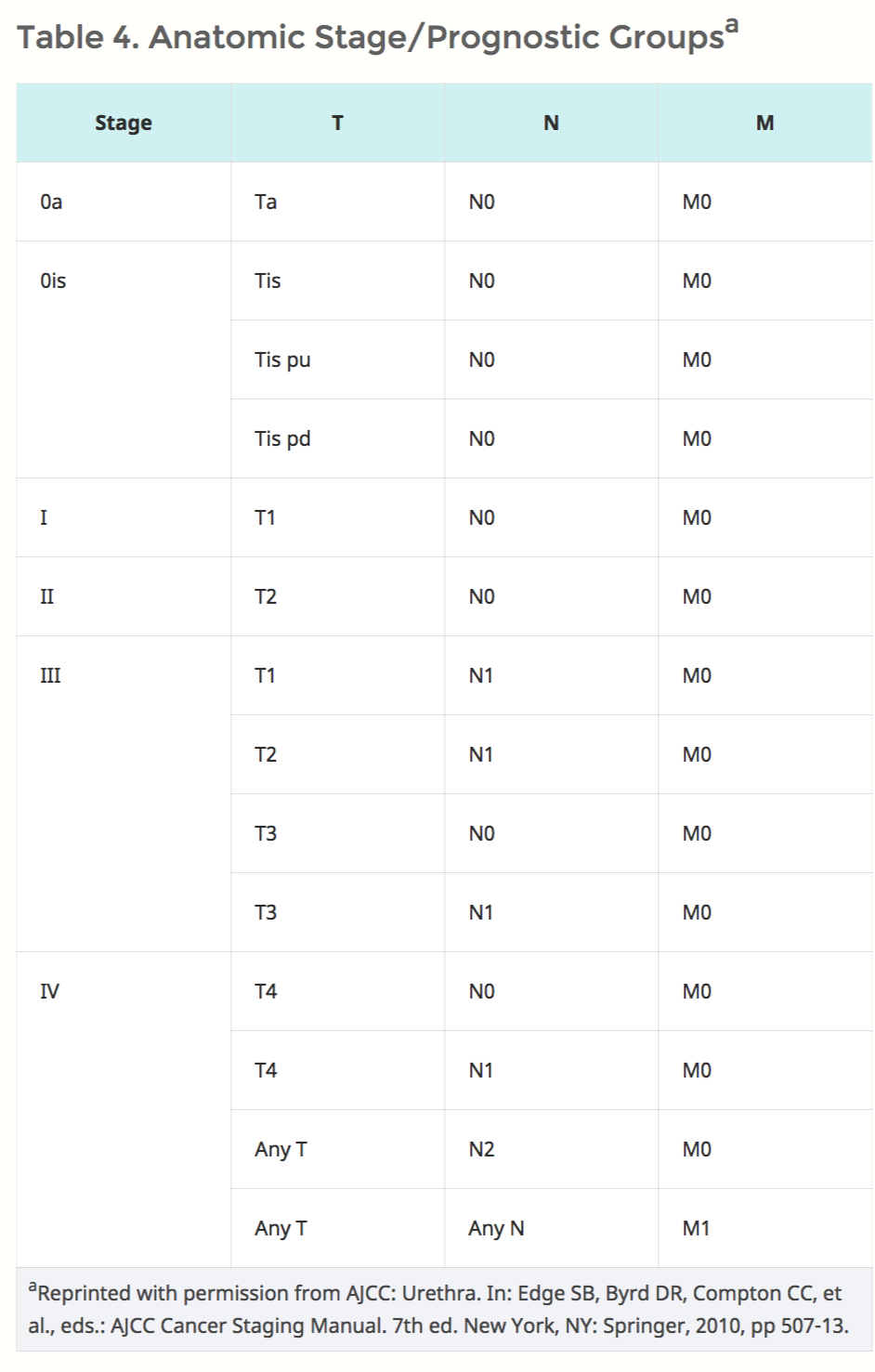Urethral cancer staging: Difference between revisions
Jump to navigation
Jump to search
Shanshan Cen (talk | contribs) |
Shanshan Cen (talk | contribs) No edit summary |
||
| Line 28: | Line 28: | ||
[[File:Urethral_Cancer3.png|thumb|none|400px|This image is provided by the National Library of Medicine.]] | [[File:Urethral_Cancer3.png|thumb|none|400px|This image is provided by the National Library of Medicine.]] | ||
[[File:Urethral_Cancer4.png|thumb|none|400px|This image is provided by the National Library of Medicine.]] | [[File:Urethral_Cancer4.png|thumb|none|400px|This image is provided by the National Library of Medicine.]] | ||
{| style="border: 0px; font-size: 90%; margin: 3px; width: 600px" align=center | |||
|valign=top| | |||
|+ | |||
! style="background: #4479BA; width: 200px;" | {{fontcolor|#FFF|TNM}} | |||
! style="background: #4479BA; width: 400px;" | {{fontcolor|#FFF| Definition}} | |||
|- | |||
| style="padding: 5px 5px; background: #DCDCDC;" |TX | |||
| style="padding: 5px 5px; background: #F5F5F5;" |Primary tumor cannot be assessed. | |||
|- | |||
| style="padding: 5px 5px; background: #DCDCDC;" |T0 | |||
| style="padding: 5px 5px; background: #F5F5F5;" |No evidence of primary tumor. | |||
|- | |||
| style="padding: 5px 5px; background: #DCDCDC;" |Ta | |||
| style="padding: 5px 5px; background: #F5F5F5;" |Noninvasive papillary, polypoid, or verrucous carcinoma. | |||
|- | |||
| style="padding: 5px 5px; background: #DCDCDC;" |Tis | |||
| style="padding: 5px 5px; background: #F5F5F5;" |Carcinoma in situ. | |||
|- | |||
| style="padding: 5px 5px; background: #DCDCDC;" |T0 | |||
| style="padding: 5px 5px; background: #F5F5F5;" |No evidence of primary tumor. | |||
|- | |||
| style="padding: 5px 5px; background: #DCDCDC;" |T1 | |||
| style="padding: 5px 5px; background: #F5F5F5;" |Tumor invades subepithelial connective tissue. | |||
|- | |||
| style="padding: 5px 5px; background: #DCDCDC;" |T2 | |||
| style="padding: 5px 5px; background: #F5F5F5;" |Tumor invades any of the following: corpus spongiosum, prostate, periurethral muscle. | |||
|- | |||
| style="padding: 5px 5px; background: #DCDCDC;" |T3 | |||
| style="padding: 5px 5px; background: #F5F5F5;" |Tumor invades any of the following: corpus cavernosum, beyond prostatic capsule, anterior vagina, bladder neck. | |||
|- | |||
| style="padding: 5px 5px; background: #DCDCDC;" |T4 | |||
| style="padding: 5px 5px; background: #F5F5F5;" |Tumor invades other adjacent organs. | |||
|} | |||
==References== | ==References== | ||
Revision as of 18:16, 11 September 2015
|
Urethral cancer Microchapters |
|
Diagnosis |
|---|
|
Treatment |
|
Case Studies |
|
Urethral cancer staging On the Web |
|
American Roentgen Ray Society Images of Urethral cancer staging |
|
Risk calculators and risk factors for Urethral cancer staging |
Editor-In-Chief: C. Michael Gibson, M.S., M.D. [1]
Overview
Urethral cancer may be classified into several subtypes based on TNM system and the depth of invasion.
Staging
Stage Definitions by Depth of Invasion
- Stage 0 (Tis, Ta): Limited to mucosa
- Stage A (T1): Submucosal invasion
- Stage B (T2): Infiltrating periurethral muscle or corpus spongiosum
- Stage C (T3): Infiltration beyond periurethral tissue
- Female: Vagina, labia, muscle
- Male: Corpus cavernosum, muscle
- Stage D1 (N+): Regional nodes; pelvic and inguinal
- Stage D2 (N+, M+): Distant nodes; visceral metastases
Definitions of TNM [1]
The American Joint Committee on Cancer has designated staging by TNM classification to define urethral cancer.




| TNM | Definition |
|---|---|
| TX | Primary tumor cannot be assessed. |
| T0 | No evidence of primary tumor. |
| Ta | Noninvasive papillary, polypoid, or verrucous carcinoma. |
| Tis | Carcinoma in situ. |
| T0 | No evidence of primary tumor. |
| T1 | Tumor invades subepithelial connective tissue. |
| T2 | Tumor invades any of the following: corpus spongiosum, prostate, periurethral muscle. |
| T3 | Tumor invades any of the following: corpus cavernosum, beyond prostatic capsule, anterior vagina, bladder neck. |
| T4 | Tumor invades other adjacent organs. |
References
- ↑ National Cancer Institute. Physician Data Query Database 2015. http://www.cancer.gov/publications/pdq